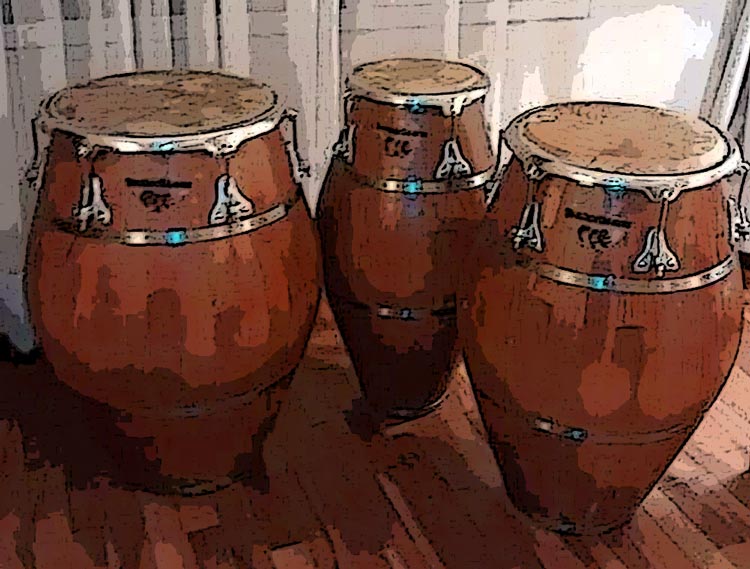Candombe originated in Uruguay between the 18th and 19th century, developed by Africans and their descendants that were taken to South America through the slave trade. The birthplace was Montevideo, Uruguay’s capital, in the Rio de la Plata region. From there, it also spread into neighboring Argentina.
Initially, candombe was the name given to the dances performed by black artists that incorporated African and European elements.
By the late 19th century, the black community in Montevideo formed comparsas. These are groups of singers, musicians and dancers that perform outdoors in carnivals and other festivities. Comparsas of various types and musical genres are found widely throughout Spain and Hispanic America.
Eventually, Uruguayan carnival comparsas became integrated, combining people of all races and ethnicities. However, Uruguayan carnival comparsas kept the barrel drums and certain dance movements rooted in African traditions. The drum section normally includes 40-80 players.
Mamá vieja and Gramillero
Two iconic figures have become regular elements in Uruguayan carnivals. In the candombe tradition, Mamá vieja (old mother) is the elder spiritual guide and the wisest woman in the community. Her outfit includes a fan with which she lures the gramillero away from the young ladies within the dance group, attracting him to dance with her.
Meanwhile, the gramillero (herb man) represents the healer of the African peoples. That’s why he carries weeds in the parade stuffed in a bag or briefcase. Another of his central elements is the cane or baton (bastón), which was traditionally used by the male elders and represents a commanding role. Additionally, the gramillero traditionally wears a top hat.
Despite these representations of elderly characters, the Mamá vieja and Gramillero are not necessarily performed by older people. In fact, for over half a century, young female dancers played elder women.
Escobero
The escobero or escobillero (the broom man) is traditionally a young man that leads the tambores (drums) down the streets. He dances with a headless broomstick used as a baton, spinning it behind his back and up and down his arms.
Candombe music and fusion
In the 20th century, candombe entered the popular music scene and was incorporated into pop, rock, jazz, and other genres. Pioneers included 1960s candombe rock trailblazers El Kinto; and 1970s jazz-rock fusion supergroup Opa that included three highly influential musicians, Ruben Rada (former El Kinto member), Hugo Fattoruso and Osvaldo Fattoruso.



Later came Uuguayan singer-songwriters, and other artists, who incorporated candombe into their music: Jaime Roos, Jorge Galemire, Mariana Ingold, Jorginho Gularte, Alberto Wolf, Fernando Ulivi, Jorge Drexler and Jorge Schellemberg. In 2003, world fusion band La Calenda Beat (2003) combined candombe with Afrobeat and jazz.
In Argentina, tango musicians such as bandoneonist Daniel Binelli, guitarist Analía Rego, Acho Estol, La Chicana, bandoneonist and singer Susana Ratcliff, among many others, incorporated candombe rhythms into some of their pieces. Another Argentine artist using candombe beats is folktronica act Chancha Via Circuito.
In the United States, Argentine singer Sofia Rei and Uruguayan vocalist Sabrina Lastman combine candombe with Latin American music and jazz.
Candombe Drums

Candombe music is characterized by the rhythms of three barrel-shaped drums, chico, piano and repique.
Chico is the smallest drum. It has a high pitch and marks the rhythm.
Repique is the medium-sized drum and is used for syncopation and improvisation.
Lastly, the piano drum is the largest one, with a lower pitch, used to play melodies.

The drums are played with one drumstick and the hand. Although the three drums vary in size and sound, they all play the same rhythm. There are three basic candombe rhythms (ritmos madre). Toque de cuareim hails from the Barrio Sur neighborhood in Montevideo. Toque de ansina from the Palermo neighborhood and toque de cordón from barrio Cordón.
Cuareim has a slow pace, while ansina and cordón are faster. The cordón beat was developed by the Pintos brothers in the mid-20th century, inspired by the ansina rhythm, although the piano drum has a bigger role in the cordón style.
In recent times, many drummers have increased the overall drumming speed, blurring the lines between the three mother rhythms.
Candombe Inscribed on the Representative List of the Intangible Cultural Heritage of Humanity
Candombe was inscribed in 2009 (4.COM) on UNESCO’s Representative List of the Intangible Cultural Heritage of Humanity. UNESCO described camdombe this way: On Sundays, and on many holidays, the llamadas de tambores de candombe (candombe drum calls) cheer up the Sur, Palermo and Cordón barrios (districts) in southern Montevideo, Uruguay. These are neighborhoods with a population of African descent.
The candombe tradition begins around communal fires as people assemble to tune their drums and mingle before beginning their march.

Once in progress, the drum-call parade is led by the most respected members, from families known by the community for their drumming for many generations. Other drummers are organized behind them in rows, and informal participants, dancers and spectators march alongside or watch from balconies.

The beat of the largest and deepest drum, the piano, is distinctive to each of the three neighborhoods, so that the structured call and response configuration of the candombe both unites the districts and indicates their individual identities.
Transmitted within families of African descent, the candombe is documented as an expression of resistance as well as a Uruguayan musical celebration and collective social practice deeply interwoven in the daily life of these neighborhoods. It is also a symbol of the memory of the community, drawing former residents back on special days to the historical center of candombe.
Candombe Schools
Tamborilarte has a music school and store as well at José E. Rodo 1994, Esq J. D. Jackson in Montevideo.
Museums
Museo del Carnaval includes candombe drum exhibits. Rambla 25 de Agosto de 1825 nº 218 (esq. Maciel) in Montevideo.


